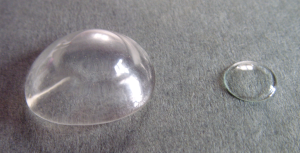For many people with severely torn ligaments or knee replacements, the ability to run and jump as though they have never been injured before remains a dream. Tissue engineering might lead to the day when damaged cartilage can simply be replaced with synthetic materials that resemble human tissue, giving injured joints new life. In an article published last week in Nature, that day comes closer when a team of eight scientists reported the synthesis of a novel hydrogel that is extraordinarily strong, stretchable and capable of self-healing.

Hydrogels are materials consisting of polymers dispersed in water. “Tofu, contact lens and cartilage are all hydrogels,” explained principal investigator Dr. Zhigang Suo, Professor of Mechanics and Materials at Harvard University, in his blog. “Tofu is brittle. We will not use tofu as a contact lens. Contact lens is tough, but much less so than cartilage. We will not use contact lens to replace cartilage. Indeed, damaged cartilage cannot be replaced today: one has to replace the entire knee with metal.”
Like human tissue, hydrogels typically comprise over 80% water, making them promising candidates for tissue replacement therapy for injuries like cartilage damage. Unfortunately, most hydrogels break at only a tenth of the pressures that cartilage can withstand. Five years ago, a Japanese team managed to produce a hydrogel that has a similar strength as cartilage. However, the material could not heal itself if it has a small crack. “Once damaged, you will need to go for replacement surgery again,” said first author Dr. Jeong-Yun Sun.
This new hydrogel is made from a combination of polyacrylamide and alginate polymers. By themselves, pure polyacrylamide and alginate hydrogels can only take 250 and 10 Jm-2 of tension before breaking. But when polyacrylamide and alginate are mixed in an 8:1 ratio in water, the resulting hybrid hydrogel can withstand tension of approximately 9000 Jm-2, almost ten times stronger than the strongest existing hydrogels. Additionally, when the hydrogel finally ruptures, it is able to heal itself to regain 74% of its strength and flexibility after a day’s rest.
“This is a very exciting piece of work, as it is unique for hydrogels to be that strong and tough, and it does appear to have the properties of cartilage,” commented Dr. Melissa Grunlan, Associate Professor of Biomedical Engineering at Texas A&M University. “But the concern is with the procedures for surgical implantation – how that might be done or if the body would tolerate the new material. For the hydrogel to be successfully applied in tissue engineering, it would need to be further explored in in-vivo tests.”
While the research needs to be continued, Dr. Suo hopes that their work will be a source of inspiration for other researchers. “We would be gratified if this paper motivates many people to study the fascinating science of fracture of hydrogels, where mechanics meets chemistry. May their imagination create new applications of tough hydrogels.”
